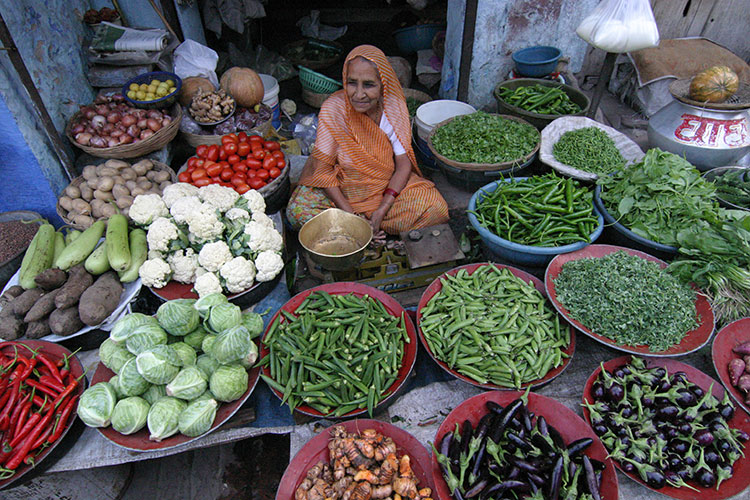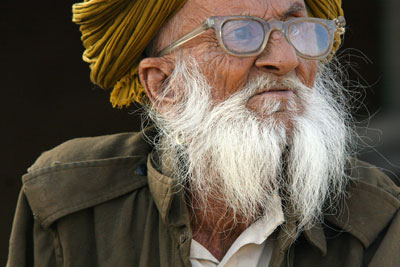Lessons in telling a story without words on a photo tour of India
This article appears on page 6 of the December 2013 issue.
Ken Mallory; Newton Highlands, MA
When Karl Grobl of Jim Cline Photo Tours promised an insider’s photo tour to the state of Rajasthan in northwest India, my wife and I decided to, in November 2012, give it a try. Our itinerary would follow much of what is called Rajasthan’s Golden Triangle — Delhi, Jaipur and Agra — and include an excursion to the far-western city of Jaisalmer and the Thar Desert on the Pakistani border, ending with a visit to the Camel Fair in Pushkar.
The guides
Jim Cline and Karl Grobl, the founding members of Jim Cline Photo Tours (San Diego, CA; 877/350-1314), divide the responsibilities for leading their tours, with Jim based more in North, Central and South America and Karl in Myanmar, Vietnam, Cambodia and India.
A slender man with a warm and inviting smile and a preference for baseball hats and sandals, Karl Grobl is a self-confessed adrenaline junkie. He bubbled with enthusiasm as he recounted past adventures and promised new ones.
“Don’t let your guard down,” Karl told us in our introductory meeting at the Hotel Taj Ambassador in New Delhi, “because some of the best pictures I’ve made were in locations that weren’t even part of the main trip. It’s about the journey we are going to take together as a group of 11. We’re going to experience the same thing, but we’re going to see different parts of it.”
The group
Besides Karl and Digvijay (D.V.) Singh, Karl’s Rajasthan-born partner on this 16-day tour ($7,675 per person, double occupancy, land only), our group of 10 included two couples from Karl’s previous trips to Southeast Asia plus a software engineer from Texas on his first Cline tour and several women who had toured South America with the company. These were uncomplaining adventurers eager to explore a different side of India.
On our first day out, we plunged into the Old City of New Delhi to catch the early-morning light. The Jama Masjid mosque, the largest in India, offered a dramatic backdrop for photographing local faces. It had a broad courtyard framing a fountain, and in the nearby sandstone alcoves, where worshipers went to find a quiet place, the light was dramatic.
As a “humanitarian photographer” who takes pictures for NGOs like World Vision, the Education Development Center and VisionFund, Karl is keenly aware of how photos tell a story, and he knows how to capture the “decisive moment” popularized by French photographer Henri Cartier-Bresson.
We soon learned that Karl was happy to leave us to explore on our own, but he was always eager to help us improve our photography with tips on where to find the best light and how to select background settings for greater impact along with suggestions on what camera settings were best for the time of day.
Karl quickly established his trademark teaching style with, “If it was me, and it is me, I would ….”
Temple visit
With the initiation to the bustle of the Jama Masjid behind us, our group hailed bicycle rickshaws to a nearby Sikh temple, Sis Ganj Gurdwara, where the Moghul emperor beheaded Sikh Guru Teg Bahadur in 1675 because the guru refused to adopt the Muslim religion.
“Any traveler from anywhere, anybody from any caste, can go in and get a free meal, all provided by the Sikhs,” Karl told us.
As we approached the entrance to the temple, we walked through a shallow stream of water sunk into marble tiles to bathe our bare feet, a ritual required of all visitors before they enter.
Amid the constant roar of traffic horns and shouting vendors in the streets, the sounds of tabla drums, chanting voices and harmonium organ music drifted down from inside the temple walls, inviting us to enter.
“Just be careful not to fall into a pot of boiling something,” Karl warned as we moved past turbaned musicians in the large entry room to enter the kitchens filled with 4-foot-wide cauldrons bubbling with dal (cooked lentils). Men, women and children sat cross-legged patting mounds of wheat dough into flattened pancakes called roti.
Besides warning us to adjust the film speed, or light sensitivity (ISO), for the varied and sometimes dark corners in the food-preparation room, Karl stressed the importance of context: the need to find an arresting background for pictures of the temple worshipers and food-preparation volunteers. Instead of snapping photos right away, we were instructed to step back and try to find archways, doorways and other backdrops that would add impact to our portraits.
Jodhpur
Following our introduction to India in New Delhi, we took a 2-hour flight to the city of Jodhpur, called the Blue City because of its many houses and structures painted in the pastel blue of the Brahmin caste. Although soothing to look at, pastel blue is a challenge to photograph. Karl made certain we were prepared.
“Blue is a tricky color for your camera’s light meter to evaluate, and if you are like me, you want that wall saturated with an awesome blue color. That is going to require close attention to your white balance … and probably a bit of underexposure.”
In typical Groblese, part California casual, part hippie revival, Karl described what we could expect.
“This is a multisensory experience, both visual and olfactory,” he began. “This is going to be a little bit fragrant at times because we are not following the tourist circuit. We are not going to just those spots where people stand and take pictures. We are going to dive right into the back alleys of the Blue City.”
Karl and D.V. had developed a well-thought-out plan for how the day would proceed. We would walk through the narrow streets in the late afternoon, visit a family whose home overlooked Mehrangarh Fort, which loomed on the horizon, then repeat the same walk along the streets early the next morning. In this way we would get the benefit of the best light the day could offer and then get a second chance to record what we had missed earlier in the day.
Each of us was locked into our own private examination of hidden alcoves and home verandas. Men played cards in the street, women swept the entrances to their homes, vendors sold candy or chai, motorbikes slid carefully past the ever-present cattle, and one family even used a clothes iron filled with steaming hot coals to press the household levis and saris.
Pushkar
A highlight of our 16-day journey through India, the Pushkar Camel Fair is an annual 5-day camel-and-livestock fair held in the town of Pushkar, where over 25,000 camels are traded each year.
“The fair has been going on for centuries and draws thousands of tourists, livestock traders, locals and Hindu faithful who come to bathe in the sacred Pushkar Lake,” Karl told us. “The most difficult thing about photographing this epic event is sensory overload.”
Wafts of cumin, cardamom, turmeric and assorted roasted and deep-fried samosas, gulab jamuns and puris flooded our senses. Against a backdrop of steep and sharply pointed hills and majestic mountain ranges, eager tradesmen strutted their horses, camels and other livestock for potential buyers. The Ferris wheels of an adjacent amusement park spun in the sunlight while wood smoke filled the air.
At the fair, Karl instructed us on panning and motion-blur techniques to add a different dimension to the portraits we had been concentrating on. By holding the camera shutter open while panning with the movement of a camel trotting past, we could keep the camel in focus while the tents and people in the background were blurred, dramatizing the feeling of movement. By shooting at slower shutter speeds of ¹⁄15 to ¹⁄25 of a second, we turned the dress of a dancing gypsy woman into a pleasing whirl.
In addition to the pilgrims who traveled to Pushkar to bathe in the sacred waters of its lake, street hustlers were everywhere, trying to attract tourist dollars. A blue boy, painted from head to toe, reprised the Hindu god Lord Shiva. Wandering monks called sadhus ambled through the streets covered in ash and facial paint. A cow with five legs (the fifth leg emerging from its neck) drew curious onlookers who were asked to pay if they wanted to take a closer look.
There was so much to see in our 2-day visit to the Pushkar fair, but, as usual, Karl managed to introduce new photo techniques he hoped we would try in our search for new images.
By now, my wife and I had come to appreciate the benefits of traveling in a small group of photographers rather than touring on our own. Besides benefiting from the guidance Karl gave us during the day, we treasured the informal noon and nighttime sessions in which we shared our images using laptops brought along for the occasion.
Although we traveled the same pathways, group members each had different visions for what they chose to record, and, by sharing these, it allowed us to learn from each other.




